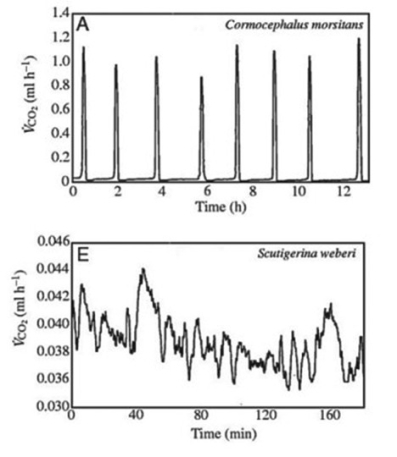Multiple Choice
Use the following information and figures to answer the question.
Many terrestrial arthropods exchange gases with their environments by using tracheae, tubes that lead from openings (called spiracles) in the animal's exoskeleton or cuticle directly to the animal's tissues. Some arthropods can control whether their spiracles are opened or closed; opening the spiracles allows the carbon dioxide produced in the tissues to travel down the tracheae and be released outside the animal. Klok et al. measured the carbon dioxide emitted over time (represented by ⱽCO₂) by several species of centipedes. The figures present graphs of their results for two species, Cormocephalus morsitans and Scutigerina weberi.
Compare the graphs in the figure of carbon dioxide (CO₂) emission for Cormocephalus morsitans and Scutigerina weberi. What hypothesis can you make about each centipede's habitat?
A) C. morsitans lives in a habitat that provides more carbon dioxide than does S. weberi.
B) C. morsitans lives in a habitat with more predators than does S. weberi.
C) C. morsitans lives in a colder habitat than does S. weberi.
D) C. morsitans lives in a drier habitat than does S. weberi.
Correct Answer:

Verified
Correct Answer:
Verified
Q1: Molecular studies have changed many of the
Q3: The sharp, inch-long thorns of the crown-of-thorns
Q4: In terms of food capture, which sponge
Q25: Use the information to answer the following
Q32: Use the following information to answer the
Q39: The sea slug Elysia chorotica has no
Q40: Whiteflies are common pest insects found on
Q43: Which characteristic is shared by cnidarians and
Q67: Which of the following combinations correctly matches
Q81: A terrestrial animal species is discovered with